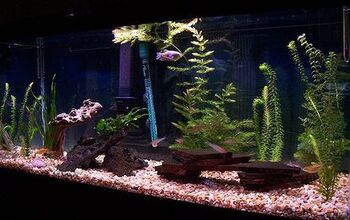4 Popular Cryptocoryne Species for Your Planted Tank

When it comes to stocking your planted tank, you have many different options to choose from. In order to make your planted tank look lush and full, you should cultivate a variety of different species. One of the best groups of live plants to use in your tank are the Cryptocoryne species.
Most Popular Cryptocoryne Species
There are approximately 60 known Cryptocoryne species and they all belong to the Araceae family of aquatic plants. These plants are all native to Asia, but they can be found in a variety of different countries including Indonesia, Malaysia, and New Guinea. What makes Cryptocorynes so popular in the planted tank world is the fact that most species grow quickly and propagate readily within the tank environment. These plants also tend to do well in low to moderate lighting and they come in a range of shapes, sizes, and colors to suit your tank.
Related: Keeping Carnivorous Plants in Your Home Aquarium
Here’s a list of some of the most popular Cryptocoryne species for planted aquariums:
- Cryptocoryne wendtii: This is the most common Cryptocoryne species kept in the freshwater tank and it is also one of the easiest to grow. This species grows long leaves which form small, thick bushes and it tends to do well in low lighting.
- Cryptocoryne crispatula: This species is available in several varieties, most of which produce light curly leaves that can grow to nearly 20 inches in length. These plants grow fairly slowly and they prefer low lighting with hard, alkaline water.
- Cryptocoryne undulate: This species is native to Sri Lanka and it produces long leaves that are green on top and red on the bottom. These plants can tolerate a wide temperature range and they can thrive in either soft or medium-hard water.
- Cryptocoryne walker: This species is very common and it grows with a more rigid structure than most Cryptocoryne species that produce compact bushes of leaves. This species grows slowly but it does propagate on its own after about six months.
These are just a few of the many Cryptocoryne species available for use in planted tanks. You may be able to find some of these species at your local pet store but, if not, you can definitely shop for them online from aquarium suppliers.
Related: Top 5 Live Plants to Use in Brackish Aquariums
Using Cryptocorynes in Your Tank
The most important thing you need to do when adding Cryptocoryne species to your planted tank is to make sure that your tank parameters meet the requirements for these plants. Different species of plants have different needs for water temperature, water hardness, and pH levels among other thing – you should match your plants to your tank, or vice versa. You also need to be intentional about where you place these plants in your tank. Most Cryptocoryne species grow very quickly in strong lighting and many of them grow very tall. This being the case, most Cryptocorynes do well as mid-ground or background plants.
Another wonderful feature of many Cryptocoryne species is their color. Many species produce bright green foliage, but some grow in red or brown. Cryptocoryne undulata, for example, grows long leaves that are green on the top and red on the bottom. If you use these or other colorful Cryptocoryne species in your tank, try to space them out among your green plants to add a pop of color and to achieve a more natural appearance. You can also use this strategy for Cryptocoryne species that produce unique leaf shapes – Cryptocoryne crispatula, for example, grows long curly leaves which can be an attractive addition to the planted tank.
As is true for any live plant, keeping Cryptocoryne species in your planted tank requires some careful planning to be sure that the needs of your plants are being met. The intensity of your lighting, the temperature of your tank water, and the water chemistry in your tank all play a role in keeping your live plants healthy and thriving.

Kate Barrington is the loving owner of two cats (Bagel and Munchkin) and a noisy herd of guinea pigs. Having grown up with golden retrievers, Kate has a great deal of experience with dogs but labels herself a lover of all pets. Having received a Bachelor's degree in English, Kate has combined her love for pets and her passion for writing to create her own freelance writing business, specializing in the pet niche.
More by Kate Barrington























